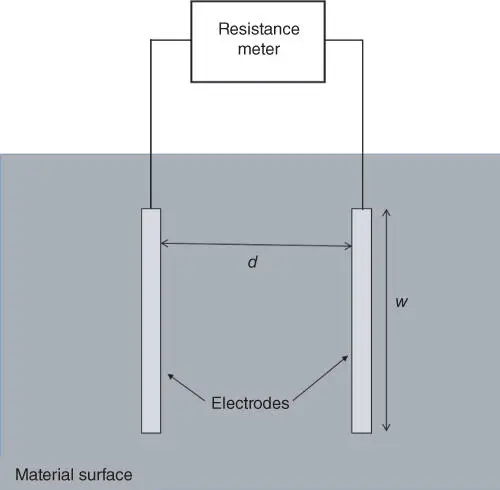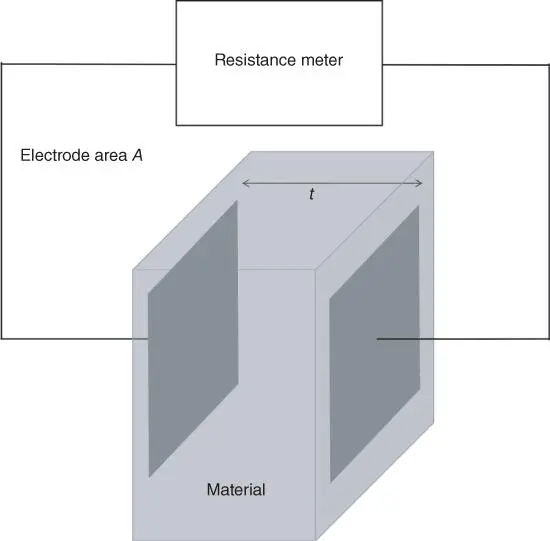The unit of surface resistivity is ohms (Ω). In some industries, it is quoted as ohms per square (Ω/sq). This reflects the property that the value of the surface resistance measured with a square electrode pattern ( d = w ) is the same, no matter what the dimension of the side of the square is.
In practice, standards exist for measuring surface resistivity using concentric ring electrodes (IEC 62631‐3‐2 (International Electrotechnical Commission 2015), IEC 16340‐2‐3, ANSI/ESD STM 11.11 (EOS/ESD Association Inc. (2015a)). This is further discussed in Chapter 11.

Figure 1.2Surface resistivity definition.
Surface resistance is a resistance measured between two electrodes on the surface of a specimen. The electrodes may be of any convenient form. Sometimes this measurement is made using electrodes designed so that conversion from surface resistance to surface resistivity is a simple calculation. In ESD control practice, conversion to surface resistivity is often not needed, and the surface resistance result obtained with defined standard electrodes is used directly.
1.7.2.2 Volume Resistance, Volume Resistivity, and Conductivity
Volume resistivity is a bulk material property based on the resistance of a cube of material with sides of unit length, with a voltage applied to two opposing faces of the cube ( Figure 1.3).
The volume resistance R vmeasured through a material of volume resistivity ρ vusing electrodes of area A is given by

where t = A = 1, or t / A = 1, which reduces to ρ v= R v.
The unit of volume resistivity is ohm meter (Ωm). The volume resistivity of a material is often simply referred to as its resistivity .
In practice, standards exist for measuring volume resistivity using concentric ring electrodes (IEC 62631‐3‐1 (International Electrotechnical Commission 2016c), IEC 61340‐2‐3 (International Electrotechnical Commission 2016b), ANSI/ESD STM 11.12 (EOS/ESD Association Inc. 2015b))

Figure 1.3Definition of volume resistivity.
Volume resistance, R v, is a resistance measured between opposing faces of a material. The electrodes may be of any convenient form. Often this measurement is made using electrodes designed for volume resistivity measurement so that conversion from volume resistance to volume resistivity is a simple calculation. In ESD work, conversion to volume resistivity is often not needed. The volume resistance obtained with defined standard electrodes is used directly, saving the effort of calculation. Examples of surface and volume resistance measurement methods are given in Chapter 11.
The conductivity, σ , of the material is simply the inverse of its resistivity.

The units of conductivity are siemens per meter (Sm −1).
The resistivity of materials can vary by many orders of magnitude from 10 −8Ωm (e.g. copper) to more than 10 15Ωm (e.g. mica, quartz, polytetrafluoroethylene, polyethylene).
1.7.3 Insulators, Conductors, Conductive, Dissipative, and Antistatic Materials
There is no fundamental definition of insulators and conductors in electrostatics. In reality, there is a continuum of material resistivity from highly conducting (low resistance) to highly insulating (very high resistance). Different industry areas may have differing views on the resistance level at which a material is considered to have insulating properties.
For our purposes, a conductor is a material that allows charge to move around on the surface or in the bulk of the material and can thereby be used to transport charge from one place to another. An insulator (nonconductor) is a material that does not allow the charge to move in this way.
One problem in practice is that a material that is considered “insulating” in one application may be considered significantly conducting in electrostatics. So, for some years I have offered the following pragmatic definitions for use in practical electrostatics and ESD control:
A conductor is a material that allows charge to move away quickly enough to avoid significant electrostatic charge build up.
An insulator is any material that is not a conductor, in other words, a material that does not allow charge to move quickly enough to avoid charge build up.
Conductors are easily maintained at a low voltage by connecting them to earth (ground). However, an insulator in electrostatic terms cannot be maintained at a low voltage by installing a ground connection. The charge on the material simply does not move to the ground connection quickly enough to be conducted away in the desired timescale.
Materials or equipment are often defined as conductors or insulators based on either their measured resistance or a charge decay time. This is discussed further in Chapter 2.
Table 1.2shows how the terms insulating , dissipative , conductive , and antistatic are widely used in ESD control. Take care when using these terms, because they may be defined differently in different contexts and may mean different things to different people. When defined in the standards, the precise definition can change as the standards evolve into new editions.
The situation becomes worse if usage of these terms in other industries and for specific products is considered ( Table 1.3). In general, these words should be considered unreliable in meaning unless specified by standards as part of an ESD control system.
Table 1.2Example of how meanings of conductive , static dissipative , insulative , and antistatic can vary with context in ESD control in electronic manufacturing.
| Term |
Application |
General use |
Meaning under 61340‐5‐1:2016a |
Meaning under S20.20‐2014 |
| Conductive |
General |
Resistance <10 6Ω |
Not defined |
Not defined |
| ESD control footwear |
|
Not defined |
Not defined |
| ESD control flooring |
<10 6Ω |
Not defined |
Not defined |
| ESD protective packaging |
|
Surface resistance <10 4Ω |
Surface and volume resistance <10 4Ω |
| Static dissipative |
General |
Resistance between 10 6and 10 11Ω |
Not defined |
Not defined |
| ESD control footwear |
|
Not defined |
Not defined |
| ESD control flooring |
≥10 6Ω |
Not defined |
Not defined |
| ESD protective packaging |
|
Surface resistance ≥10 4and ≤10 11Ω |
Surface and volume resistance ≥10 4and <10 11Ω |
| Insulative |
General |
Resistance over 10 11Ω |
Not defined |
Not defined |
| ESD control footwear |
|
Not defined, but by implication >10 8Ω |
Not defined, but by implication resistance >10 9Ω |
| ESD control flooring |
|
Not defined |
Not defined |
| ESD protective packaging |
|
Surface resistance ≥10 11Ω |
Surface and volume resistance ≥10 11Ω |
| Antistatic |
General |
Widely used to described materials used in static control; can mean almost anything |
Not defined |
The property of a material that inhibits triboelectric charging (ESD ADV1.0‐2009) |
| ESD control footwear |
Note: Has defined meaning under ISO 20345 in process industry hazard work |
Not defined |
Not defined |
| ESD control flooring |
|
Not defined |
Not defined |
| ESD protective packaging |
|
Not defined |
Materials that have reduced amount of charge accumulation as compared with standard packaging materials |
Table 1.3Example of how meanings of conductive , dissipative , and insulative can vary with context in static control in other industries (IEC 60079‐32‐1:2013).
Читать дальше
















